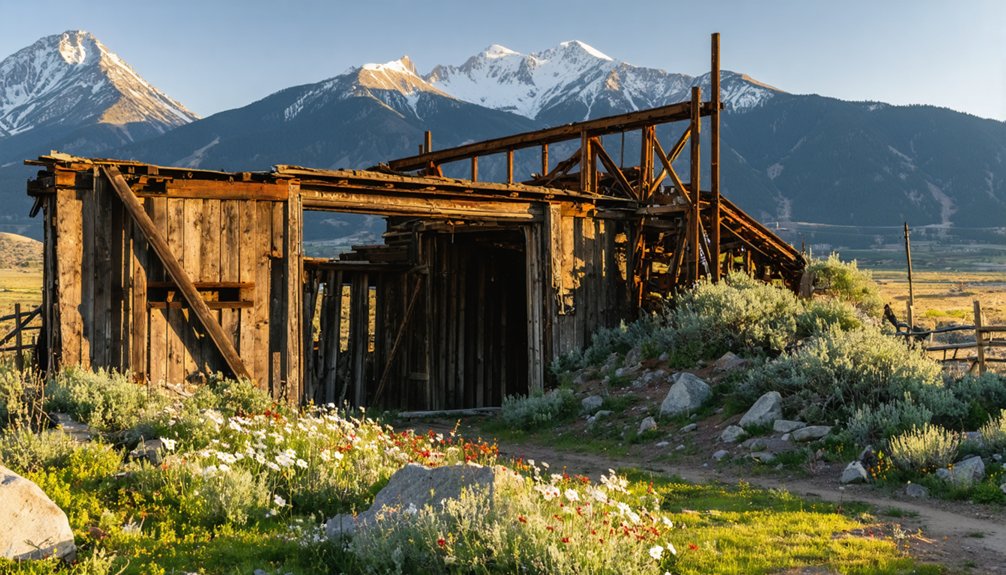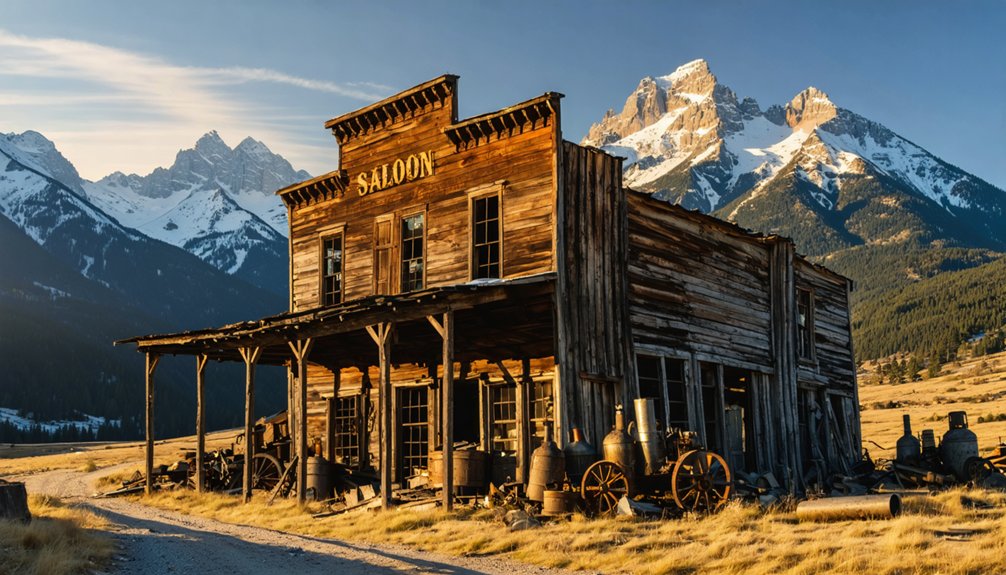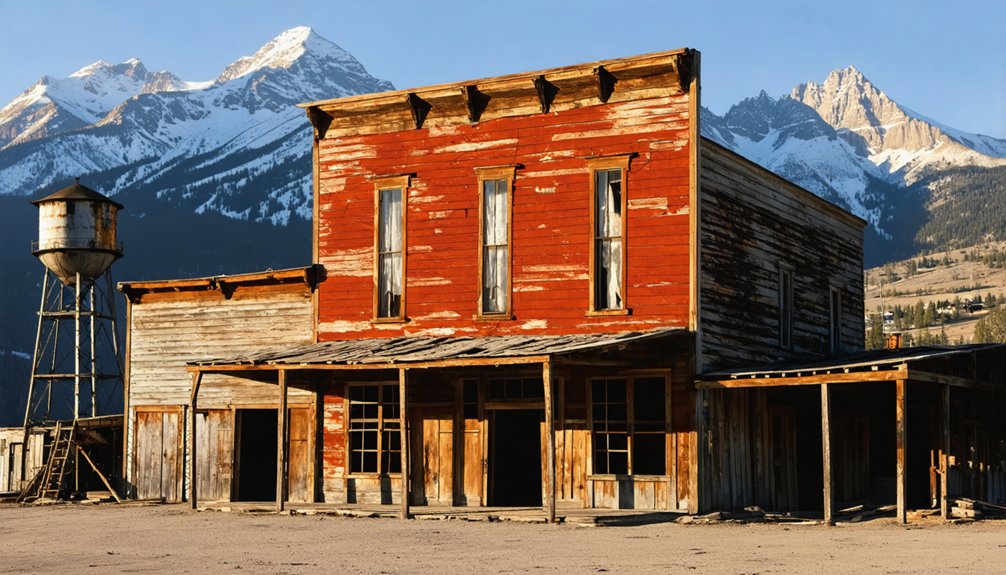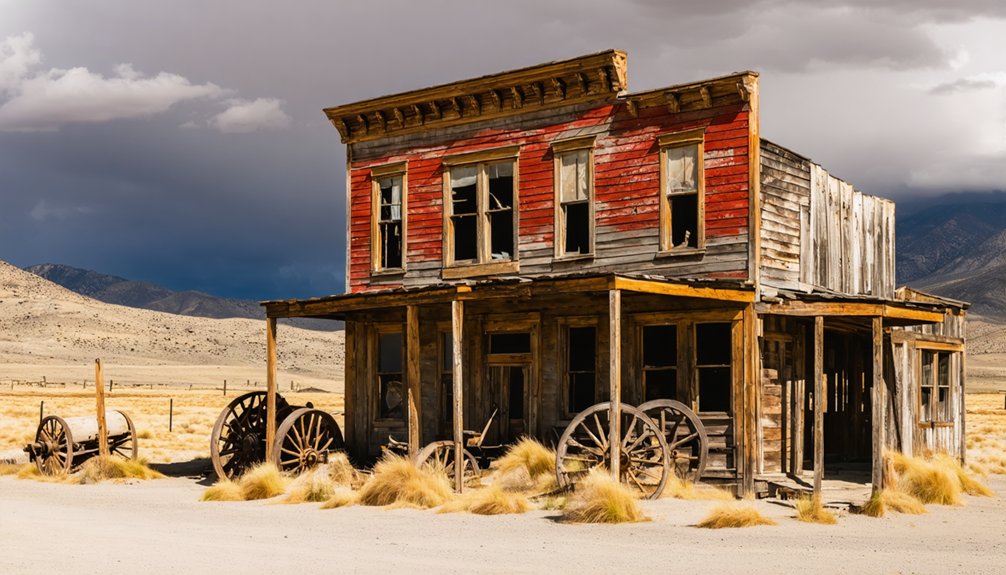Leadville’s ghost towns offer glimpses into Colorado’s silver boom era. You’ll discover well-preserved Winfield with its Victorian log cabins, the Ball Cabin museum displaying mining artifacts, and remote sites like Vicksburg with its innovative water systems. Access requires planning and appropriate vehicles, with summer providing the safest exploration time. These weathered structures and mining remnants stand as silent witnesses to the dramatic boom-and-bust cycle that shaped the American West.
Key Takeaways
- Leadville’s surroundings contain numerous ghost towns like Winfield, with preserved Victorian structures and mining artifacts documenting Colorado’s silver boom era.
- Four original log structures in Winfield, including Ball Cabin museum, showcase authentic mining-town architecture from the 1890s boom period.
- Access requires planning with appropriate vehicles, as gravel roads transition to rugged trails only reliably accessible during summer months.
- Safety hazards include unmarked mine shafts and unstable structures, with limited amenities and interpretive signage at most sites.
- Visitors can explore Harrison Reduction Works smelter foundation, Swiss Boy Mine, and Fortune Mine for insights into early mining techniques.
The Silver Boom That Built Leadville’s Ghost Empire
While the Colorado Rockies had witnessed gold rushes before, nothing could have prepared the region for the explosive silver boom that transformed Leadville from a minor settlement into a mining metropolis almost overnight.
When prospectors discovered cerussite containing 15 ounces of silver per ton in 1877, they unknowingly triggered an economic revolution. By 1879, the Leadville lode discovery initiated a migration that swelled the population to nearly 30,000 by 1880, making it Colorado’s second-largest city. The boom continued until the Sherman Silver Purchase Act was repealed in 1893, causing silver prices to collapse and ending the era of prosperity.
You can still trace the ambition in the remains of seventeen smelters and over 100 miles of railroad tracks built to serve the silver mining operations. The economic impact was staggering—$82 million in silver extraction established fortunes for figures like Horace Tabor and the Guggenheims. At its peak, Leadville stood as the highest incorporated town in North America at 10,150 feet above sea level, a testament to the determination of those who built this remarkable mining community.
Exploring Winfield: A Glimpse Into Mining’s Golden Age
As you traverse Winfield’s quiet trails today, you’re walking through the skeletal remnants of an 1890s boomtown where over 1,500 miners once sought their fortunes in silver and gold.
The preserved Ball cabin museum and Victorian-era structures stand as silent witnesses to the ambitious mining operations that once carved through these mountains with 3,700-foot tunnels and eight-claim operations. Many visitors express deep curiosity about the harsh living conditions these miners endured. The town boasted multiple saloons and stores during its heyday, providing essential services to the mining community.
Your footsteps echo across a timeline from 1861 to 1918, when the last ore-laden wagons departed, leaving behind a pristine ghost town that now sits peacefully within San Isabel National Forest.
Mining Boom Remnants
Nestled at the junction of Clear Creek’s north and south forks, Winfield stands today as a perfectly preserved time capsule from Colorado’s mining golden age.
Your ghost town exploration reveals tangible connections to the area’s vibrant mining heritage through four original log structures, including the schoolhouse and Ball Cabin museums where historic photographs and artifacts await your discovery.
Venture beyond the town center to experience abandoned mines that once produced silver, gold, and copper. Much like Leadville’s remarkable recovery after the 1893 crash, mining operations here demonstrated the incredible resilience of Colorado’s mining communities.
The Swiss Boy Mine, accessible via a 9% grade trail, offers glimpses of early mining techniques. At Fortune Mine, you’ll find infrastructure remnants that silently testify to the boom-bust cycle that defined these mountain communities.
These sites, though quiet now, echo with the industry that once supported 1,500 residents before the 1893 silver crash abruptly ended Winfield’s prosperity.
Preserved Victorian Structures
Victorian elegance stands frozen in time throughout Winfield’s preserved structures, offering you a rare window into Colorado’s mining-era architecture.
The four original log buildings—including the schoolhouse and Ball Cabin museum—showcase Victorian craftsmanship that flourished during the silver boom.
At the Ball Cabin, you’ll discover historic photographs and mining artifacts that tell the story of Winfield’s economic and cultural evolution.
This architectural significance extends beyond individual buildings to reveal how entire communities developed around Tasmania, Swiss Boy, Fortune, and Banker mines.
Unlike Leadville’s grander Victorian structures like the Tabor Opera House, Winfield’s humble log architecture represents the authentic foundation of mining communities.
These preserved buildings provide tangible evidence of how settlement patterns adapted to the harsh mountain environment while maintaining Victorian design elements.
The lawless atmosphere of early mining settlements contributed to Winfield’s unique development, with structures designed for both function and protection against swindlers and gamblers.
Winfield’s historical significance was recognized in 1966 when it was included in Leadville’s National Historic District designation, protecting these structures for future generations.
Journey Through Time
Journey Through Time
Exploring Winfield: A Glimpse Into Mining’s Golden Age
When you step onto Winfield’s weathered streets today, you’re walking the same paths that ambitious prospectors tread in 1861 when they founded this silver boomtown at the junction of Clear Creek’s north and south forks.
Vicksburg and Columbia City: Forgotten Mountain Communities
While the mining metropolis of Leadville cast a long shadow over Colorado’s mineral rush, the smaller communities of Vicksburg and Columbia City carved their own remarkable stories into the rugged Clear Creek Canyon landscape.
Vicksburg history began in 1867 when gold-seeking prospectors stumbled upon riches after losing their pack burros. The town flourished with 600-700 residents until the 1893 silver crash devastated its economy. The town’s innovative water system was created using ditches from Vicksburg Creek that served multiple purposes including fire control and food preservation.
Today, you’ll find one of Colorado’s best-preserved ghost towns, complete with original cabins and Balm of Gilead trees planted by miners themselves.
In stark contrast, Columbia City remnants sit precariously above treeline, requiring four-wheel drive and hiking to access. Few structures survive the harsh high-altitude conditions, but the site offers extraordinary mountain views worth the challenging journey.
What Remains of Oro City and Rockdale Today

You’ll find Oro City and Rockdale reduced to weathered remnants, with Oro City’s ruins accessible via Highway 24 and County Road 39, while Rockdale’s deteriorated structures require more challenging navigation through rugged mountain terrain.
Both sites bear silent testimony to their brief but intense mining histories—Oro City’s three-million-dollar gold strike and Rockdale’s connection to the broader Leadville mining economy now visible only in collapsed buildings and hazardous abandoned shafts.
The harsh mountain climate continues to accelerate the decay of these once-bustling communities, presenting preservation challenges while offering visitors a tangible connection to Colorado’s gold and silver rush era. The elevation of Cloud City Leadville at 10,430 feet contributes to the extreme weather conditions that have eroded these historical sites over time. Following the Pikes Peak gold rush of 1859, these sites experienced the boom-and-bust cycle that characterized mining towns throughout Colorado’s frontier history.
Remaining Structure Inventory
The ghostly remnants of Oro City and Rockdale tell a story of abandonment through their scattered ruins rather than through preserved structures. In your ghost town exploration, you’ll find only foundations, collapsed ruins, and rotten wood marking what were once thriving communities.
Mining history reveals itself through deteriorated infrastructure—sluice box fragments, tailings piles, and mineral dumps that dot the landscape.
At both sites, you’ll discover mostly mining-related foundations, collapsed cabins, and earthworks that have surrendered to decades of weathering and erosion. The Harrison Reduction Works smelter foundation stands as one of the more substantial remains.
No active preservation protects these sites; nature reclaims them steadily. Warning signs keep you from dangerous mine shafts, but the surrounding foundations and gravel piles remain accessible witnesses to bygone prosperity.
Accessing The Ruins
Reaching these mountain ghost towns requires deliberate planning and appropriate vehicles, as both Oro City and Rockdale sit tucked away in gulches that demand effort to access.
Gravel roads shift to rugged hiking trails that snake through pine forests and open gulches with grades reaching 9%. Summer months offer your only reliable window for exploration; winter snows render these paths impassable.
Be vigilant of numerous safety hazards throughout these sites—unmarked mine shafts, unstable structures, and toxic contaminants from the California Gulch Superfund site demand your respect.
You won’t find amenities or interpretive signage at the ruins themselves, so bring maps or GPS guides. While Leadville offers museums explaining the area’s history, at the sites you’re on your own among foundations, mining debris, and the haunting remains of industrial ambition.
Preservation Challenges Today
Standing silent against the Colorado sky, what remains of Oro City and Rockdale today presents preservationists with formidable challenges that extend beyond mere structural decay.
You’ll find only collapsed ruins and scattered foundations where buildings once housed 10,000 souls during the boom years that produced 4-5 metric tons of gold.
Without active preservation strategies, these historical remnants continue to deteriorate. The sites suffer from dual threats: natural erosion and environmental contamination, with California Gulch designated as a Federal Superfund site due to heavy metal contamination and acidic drainage.
The absence of dedicated funding sources further complicates conservation efforts.
As you walk the Route of the Silver Kings, witnessing these ghostly foundations, you’re experiencing a landscape caught between historical significance and environmental remediation—a precarious balance that may determine whether future generations will glimpse Colorado’s mining heritage.
The Route of the Silver Kings: A Self-Guided Adventure

Winding through a 20-square-mile historic mining district that surrounds Leadville, the Route of the Silver Kings offers you an unparalleled self-guided adventure into Colorado’s silver mining past.
This 20-mile journey connects 14 carefully preserved stops including weathered mine ruins, ghost towns, and historic camps that document Colorado’s most productive silver mining district.
You’ll discover sites like the Resurrection Mine with its 1,000-foot shaft, the innovative wire-rope tramway at Fanny Rawlings Mine, and the Little Bob Mine where ore yielded over 50 ounces of silver per ton.
Grab your heritage guide at Leadville’s Visitor Center or access virtual navigation through RouteoftheSilverKings.org.
The dirt roads are passable in most vehicles, allowing you to freely explore these historic preservation treasures while witnessing the remarkable 140-year legacy of mining wealth that transformed this landscape.
Architectural Treasures in Leadville’s Historic District
Beyond the rugged mining terrain and remote ghost towns, Leadville’s Historic District presents another dimension of silver rush heritage through its remarkable architectural legacy.
Designated a National Historic Landmark in 1961, the district’s 70 square blocks showcase exquisite 19th-century Victorian Architecture and Romanesque Revival styles.
Leadville’s historic landmark district reveals America’s silver rush grandeur through pristine Victorian and Romanesque architectural treasures.
As you explore this living museum of the silver boom era, notice:
- The lavish French mansard roofs and central towers adorning opulent structures like the Tabor Opera House
- The Romanesque three-story American National Bank Building, crafted from sandstone at a cost of $35,000
- The English Gothic “Old Church” on Harrison Avenue, maintaining its architectural integrity since 1889
- The Historic Preservation Commission’s ongoing efforts to maintain authenticity through Certificates of Appropriateness
Haunted History: The Spectral Side of Mining Towns

Beneath the weathered facades and crumbling mine structures of Leadville lies a darker dimension of its silver boom heritage—one populated by restless spirits and supernatural occurrences that have captivated residents for generations.
You’ll discover the Moyer Mine, where Senator Gallagher’s ghost descends in mine buckets to warn of impending danger—one of many spectral legends tied to tragic mining accidents.
At the New Discovery Mine, miners once fled their posts after encounters with a shroud-wearing female apparition who reportedly spat at them before vanishing.
The Brooklyn Heights haunting of 1880 drew investigators from across town, while the Morning Star Mine’s ghostly encounters became regional news.
As you walk the Mineral Belt Trail or visit Evergreen Cemetery, these stories persist not as mere folklore but as living proof of Leadville’s mysterious past.
Frequently Asked Questions
Are Leadville’s Ghost Towns Accessible During Winter Months?
Most of Leadville’s ghost towns have limited winter accessibility. You’ll find Vicksburg and Winfield open year-round via CR 390, while snow blocks ghost town trails to Independence and restricts Columbia City exploration.
What Safety Precautions Should Visitors Take When Exploring Abandoned Mines?
Never enter abandoned mines. You’ll guarantee mine safety by viewing structures only from outside, staying on marked paths, avoiding unstable ground, and respecting warning signs. These exploration tips protect your freedom.
Can Visitors Legally Collect Artifacts From Ghost Town Sites?
Walking through history’s footprints, you can’t legally pocket ghost town treasures. Artifact preservation laws impose strict legal restrictions on collection. Instead, document your discoveries without disturbing these irreplaceable historical contexts.
How Did Miners Survive Harsh Mountain Winters at 10,000 Feet?
You’d survive Leadville’s brutal winters by huddling in makeshift shelters, conserving heat, and relying on mining techniques that kept you underground where temperatures remained constant despite the frigid mountain air above.
Which Ghost Towns Near Leadville Allow Overnight Camping?
Pristine primitive possibilities await you at Winfield, Vicksburg, and Rockdale ghost towns. You’ll find dispersed camping with minimal regulations—just use existing sites and pack out trash. Crescent Mining Camp offers reservable historic cabins.
References
- https://leadville.com/the-ghost-towns-of-leadville-and-beyond/
- https://skjtravel.net/index.php/15-features/484-ruins-of-the-silver-mining-boom-in-leadville-colorado
- https://www.uncovercolorado.com/vicksburg-winfield-ghost-towns/
- https://leadville.com/take-a-tour-to-learn-more-about-leadvilles-history/
- https://www.uncovercolorado.com/ghost-towns/oro-city/
- https://www.academia.edu/37978546/Silver_Boom_The_Rise_and_Decline_of_Leadville_Colorado_as_the_United_States_Silver_Capital_1860_1896
- https://www.leadvilletwinlakes.com/blog-ghosts-of-leadville-colorado/
- https://leadville.com/historic-leadville-walking-tour/
- https://en.wikipedia.org/wiki/Leadville
- https://leadville.com/category/history/mines/



